Operating OpenShift: An SRE Approach to Managing Infrastructure (Final)
- Добавил: literator
- Дата: 8-11-2022, 05:37
- Комментариев: 0
 Название: Operating OpenShift: An SRE Approach to Managing Infrastructure (Final)
Название: Operating OpenShift: An SRE Approach to Managing Infrastructure (Final)Автор: Rick Rackow, Manuel Dewald
Издательство: O’Reilly Media, Inc.
Год: 2023
Страниц: 300
Язык: английский
Формат: epub
Размер: 10.16 MB
Kubernetes has gained significant popularity over the past few years, with OpenShift as one of its most mature and prominent distributions. But while OpenShift provides several layers of abstraction over vanilla Kubernetes, this software can quickly become overwhelming because of its rich feature set and functionality. This practical book helps you understand and manage OpenShift clusters from minimal deployment to large multicluster installations.
Principal site reliability engineers Rick Rackow and Manuel Dewald, who worked together on Red Hat's managed OpenShift offering for years, provide valuable advice to help your teams operate OpenShift clusters efficiently. Designed for SREs, system administrators, DevOps engineers, and cloud architects, Operating OpenShift encourages consistent and easy container orchestration and helps reduce the effort of deploying a Kubernetes platform. You'll learn why OpenShift has become highly attractive to enterprises large and small.
OpenShift is a platform, built to help software teams develop and deploy their distributed software. It comes with a large set of tools that are built in or can be deployed easily. While it can be of great help to its users and can eliminate a lot of traditionally manual operations burdens, OpenShift itself is a distributed system that needs to be deployed, operated, and maintained.
Many companies have platform teams that provide development platforms based on OpenShift to software teams so the maintenance effort is centralized and the deployment patterns are standardized across the organization. These platform teams are shifting more and more into the direction of Site Reliability Engineering (SRE) teams, where software development practices are applied to operations tasks. Scripts are replaced by proper software solutions that can be tested more easily and deployed automatically using continuous integration/continuous delivery (CI/CD) systems. Alerts are transformed from simple cause-based alerts like “a high amount of memory is used on Virtual Machine 23” into symptom-based alerts based on Service Level Objectives (SLO) that reflect customer experience, like “processing of requests takes longer than we expect it to.”
OpenShift provides all the tools you need to run software on top of it with SRE paradigms, from a monitoring platform to an integrated CI/CD system that you can use to observe and run both the software deployed to the OpenShift cluster, as well as the cluster itself. But building the automation, implementing a good alerting strategy, and finally, debugging issues that occur when operating an OpenShift cluster, are still difficult tasks that require skilled operations or SRE staffing.
Learn OpenShift core concepts and deployment strategies
Explore multicluster OpenShift Container Platform deployments
Administer OpenShift clusters following best practices
Learn best practices for deploying workloads to OpenShift
Monitor OpenShift clusters through state-of-the-art concepts
Supplemental material (code examples, exercises, etc.) is available for download at GitHub.
Скачать Operating OpenShift: An SRE Approach to Managing Infrastructure
[related-news] [/related-news]
Внимание
Уважаемый посетитель, Вы зашли на сайт как незарегистрированный пользователь.
Мы рекомендуем Вам зарегистрироваться либо войти на сайт под своим именем.
Уважаемый посетитель, Вы зашли на сайт как незарегистрированный пользователь.
Мы рекомендуем Вам зарегистрироваться либо войти на сайт под своим именем.
